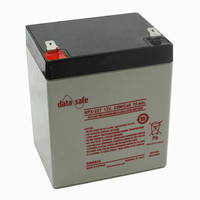NPX-25T EnerSys, NPX-25T Datasheet - Page 11

NPX-25T
Manufacturer Part Number
NPX-25T
Description
DATASAFE NPX LEAD ACID BATT 12V
Manufacturer
EnerSys
Specifications of NPX-25T
Voltage - Rated
12V
Rechargeability
Yes
Lead Free Status / RoHS Status
Contains lead / RoHS compliant by exemption
Size / Dimension
-
Termination Style
-
Capacity
-
Other names
Q5397175
www.enersys.com
■
The charging voltage should be regulated according to the
type of service in which the battery will be used. Generally,
the following voltages are used at 25˚C (77˚F).
For standby (float) use . . . . . . . 2.25 to 2.30 volts per cell
For cyclic use . . . . . . . . . . . . . 2.40 to 2.50 volts per cell
In a constant voltage charging system, a large amount of
current will flow during the initial stage of charging, and
decreases as the charging progresses. When charging at 2.30
volts per cell, charging current at the final stage of charging
will drop to as little as 0.002CA.
Charging voltage should be regulated in relation to the
ambient temperature. When the temperature is higher, the
charging voltage should be lower. When the temperature is
lower, the charging voltage should be higher. For specific
recommendations, please refer to the section on Temperature
Compensation. Similarly, capacity (measured in ampere-
hours) attainable over time will vary in direct relation to the
ambient temperature. The capacity in a given period of time
will be larger at higher temperatures, and smaller at lower
temperatures.
■
A discharged battery will accept a high charging current at the
initial stage of charging. High charging current can cause
abnormal internal heating which may damage the battery.
Therefore, it is recommended that the charging current be
normally limited to 0.25CA. However, in standby use, Genesis
NP batteries are designed so that even if the charging current
is higher than the recommended limit, they will not accept
more than 2CA, and the charging current will be reduced to a
relatively small value in a very brief period of time. Therefore,
in standby use, no current limit is required. Figure 11 shows
current acceptance in Genesis NP batteries charged at
constant voltage, with no current limit.
When designing a charger, it is recommended that a current
limiting function be provided in the charger in order to
prevent charger failure due to overheating of the transformer,
or other damage resulting from mishandling, i.e., short
circuiting or reversing polarity.
Figure 11.
Charging Voltage
Initial Charge Current Limit
Constant-Voltage Charge Characteristics with no
Current Limit
TEMPERATURE: 25ºC (77ºF)
CHARGE VOLTAGE: 2.30V/C
■
Since any battery loses capacity through self-discharge, it is
recommended that a “refresh charging” be applied to any
battery which has been stored for a long period of time, prior
to putting the battery into service. Excepting conditions in
which storage temperature have been abnormally high,
refresh charging is recommended within the following
parameters:
Genesis NP batteries must not be allowed to self-discharge to
less than 2.08 volts per cell on open circuit. To recover deeply
discharged batteries, charge them for 24 hours using a
constant voltage charger set at 2.40 volts per cell at 25˚C
(77˚F) with a maximum current of 0.15C. A 16-hour recovery
charge is possible by setting the charge voltage at 2.45 volts
per cell and a maximum current of 0.25C.
In view of the above, consideration should be given to the fact
that if the charging method used is constant voltage in which
the charger employs current sensing for either state of charge
indication or for reducing voltage (a two step charger), during
the initial stage of charging an over-discharged battery the
charger may give a false “full charge” indication, or may
initiate charge at a float voltage.
■
As temperature rises, electrochemical activity in a battery
increases. Similarly, as temperature falls, electrochemical
activity decreases. Therefore, conversely, as temperature
rises, charging voltage should be reduced to prevent
overcharge, and increased as temperature falls to avoid
undercharge. In general, to assure optimum service life, use
of a temperature compensated charger is recommended.
The recommended compensation factor for Genesis NP
batteries is -3mV/
use). The standard center point for temperature compensa-
tion is 25
temperatures and charging voltages in both cyclic and
standby applications.
after manufacture
Within 12 months
after manufacture
Within 6 months
Battery Age
Refresh Charging
Temperature Compensation
0
C (77
0
F). Figure 12 shows the relationship between
4 to 6 hours at constant current of 0.1CA, or 15 to 20
hours at constant voltage of 2.40 volts per cell.
8 to 10 hours at constant current of 0.1CA, or 20 to 24
hours at constant voltage of 2.40 volts per cell.
0
C/Cell (stand by) and -4mV/
Refresh Charging Recommendations
Publication No: US-NP-AM-002 • June 2006
0
C/Cell (cyclic
11









